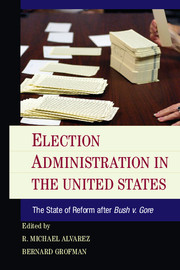Book contents
- Frontmatter
- Contents
- List of Contributors
- Foreword
- Acknowledgments
- Editors’ Introduction
- Part I Bush v. Gore in Perspective
- Part II What Has Changed since Bush v. Gore?
- Part III Remaining Challenges
- 8 The Evolution (or Not) of Ballot Design Ten Years after Bush v. Gore
- 9 Poll Workers and Polling Places
- 10 Resolving Voter Registration Problems
- 11 Felon Disenfranchisement after Bush v. Gore
- Epilogue
- References
- Index
11 - Felon Disenfranchisement after Bush v. Gore
Changes and Trends
Published online by Cambridge University Press: 05 October 2014
- Frontmatter
- Contents
- List of Contributors
- Foreword
- Acknowledgments
- Editors’ Introduction
- Part I Bush v. Gore in Perspective
- Part II What Has Changed since Bush v. Gore?
- Part III Remaining Challenges
- 8 The Evolution (or Not) of Ballot Design Ten Years after Bush v. Gore
- 9 Poll Workers and Polling Places
- 10 Resolving Voter Registration Problems
- 11 Felon Disenfranchisement after Bush v. Gore
- Epilogue
- References
- Index
Summary
On November 7, 2000, Marie Jackson attempted to cast a ballot in what would become one of the most contested elections of our time. She gave her name and identification to a poll worker but was told that she wasn’t on the list of registered voters. Despite her pleas, Jackson was not allowed to vote. She later learned from a neighbor working the polls that her name appeared on a list of more than 80,000 Florida residents who were barred from voting because of a prior felony conviction. The list also contained the names of thousands of state residents who were “suspected felons” and matched by simple characteristics such as name or date of birth. Individuals with common names ran a high risk of being mistakenly included on the list. Another 8,000 Florida residents who were convicted of misdemeanor offenses were erroneously included in the felon purge list while nearly 5,000 citizens whose voting rights had been restored were still banned from voting. In all, nearly 1 million Florida residents were barred from voting in the 2000 presidential election. The brunt of that exclusion was particularly harsh for African Americans, who comprised about 32 percent of Florida’s disenfranchised population (Brown-Dean, forthcoming). One in every three black male residents of Florida was barred from voting.
Two years prior, the state of Florida had signed a $4 million contract with a company called Data Base Technologies to cleanse the voting rolls of felons and create a central voter file. The push to cleanse the voting rolls resulted from allegations that the former mayor of Miami, Republican Xavier Suarez, received votes from felons, noncitizens, and the deceased during his 1997 bid for office (Navarro, 1998). The investigation into fraudulent voter rolls resulted in the arrest of the city commissioner and his staff and Suarez’s removal from office. In theory, the creation of a central voter file seemed like an appropriate way of protecting the integrity of the electoral process. In practice, this process set in motion a protracted national conversation regarding the fairness and consequences of felon disenfranchisement.
- Type
- Chapter
- Information
- Election Administration in the United StatesThe State of Reform after Bush v. Gore, pp. 199 - 211Publisher: Cambridge University PressPrint publication year: 2014
- 1
- Cited by



